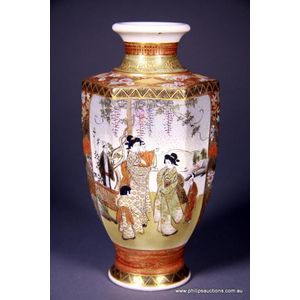Signed Satsuma Vase with Figural Narrative Scenes
You must be a subscriber, and be logged in to view price and dealer details.
Subscribe Now to view actual auction price for this item
When you subscribe, you have the option of setting the currency in which to display prices to $Au, $US, $NZ or Stg.
- Circa - A Latin term meaning 'about', often used in the antique trade to give an approximate date for the piece, usually considered to be five years on either side of the circa year. Thus, circa 1900 means the piece was made about 1900, probably between 1895 and 1905. The expression is sometimes abbreviated to c.1900.
- Cartouche - An ornamental panel in the form of of a shield, oval or rectangular scroll with curling edges. It may be carved into the back of a chair or the top of a sideboard, or present on a piece of silver or jewellery, and contain the initials of the original owner, heraldic symbols, or some other inscription, such as the details of a presentation.
In ceramics the term defines the central area of a vase or similar with a decorative border in one of the shapes above, into which a decorative scene or figures have been painted. - Gilding - Gilding is a method of ornamentation whereby a thin sheet of gold metal is applied to items made of wood, leather, ceramics, glass and silver for decorative purposes.
For furniture including mirrors, the sheet of gold is usually applied over a coating of gesso. Gesso is a mixture of plaster of Paris and gypsum mixed with water and then applied to the carved wooden frames of mirrors and picture frames as a base for applying the gold leaf. After numerous coats of gesso have been applied, allowed to dry and then sanded a coat of "bole", a usually red coloured mixture of clay and glue is brushed on and allowed to dry, after which the gold leaf is applied. Over time parts of the gilding will rub off so the base colour can be seen. In water gilding, this was generally a blue colour, while in oil gilding, the under layer was often yellow. In Victorian times, gilders frequently used red as a pigment beneath the gold leaf.
Metal was often gilded by a process known as fire gilding. Gold mixed with mercury was applied and heated, causing the mercury to evaporate, the long-term effect of which was to kill or disable the craftsman or woman from mercury poisoning. The pursuit of beauty has claimed many victims, not the least of which were the artists who made those pieces so highly sought after today.
This item has been included into following indexes:
- Japanese ceramics, item types - other 2,525
-
Satsuma (Japan), item type
- figures and figurines 217
- other items 2,034
- vases 1,376
Visually similar items

Satsuma blue ground gilded figured panelled vase, signed to the base Kinkozan. 16 cm high

A large Satsuma vase. 19th century, having a folded fabric style neck and applied side tassel cords, the baluster vase with an all over scene in autumnal coloured enamels and gilt upon a beige ground of various bijin in a pavilion setting, and to the rever

A Satsuma vase by Ryokuzan, Meiji period, the ovoid body decorated in polychrome enamels and gilding with on one side maidens in a garden setting with distant view of Mt. Fuji, and the reverse with a twin duck-shaped panel enclosing a landscape and florett

A fine Dr Wall Worcester Chinoiserie vase, circa 1765, the baluster vase decorated in the mandarin palette with 'Long Eliza' Chinese figures and furnishings reserved within gilded arabesques and iron red leaf borders; illustrated in Spero and Sandon's 'Wor
